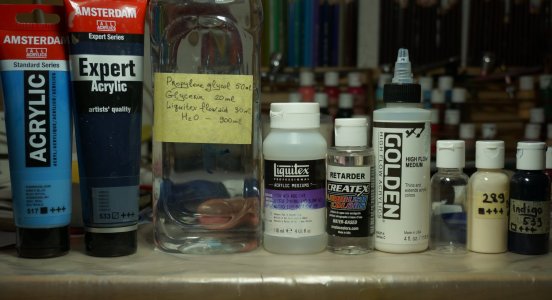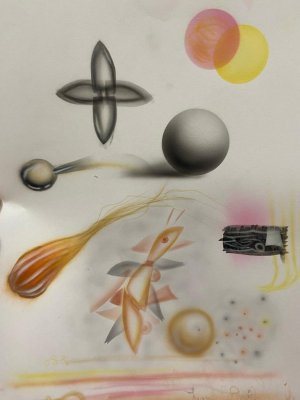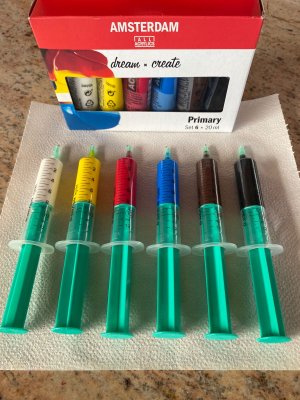Mitya Ka
Needle-chuck Ninja
Since the time when I completely switched from oil painting to acrylic painting, I had the task of smooth color transition, gradient of tone and with these were problems until I had an airbrush in my hands. Acrylic paint which at that moment I used had to be adapted for spraying. At first I tried to dilute it with water and even alcohol in different proportions, it was atomized, but I was not happy with the result. By the method of trial and error, communication with artists and chemists, searching for information on YouTube and forums came to the following recipe for airbrush paint, which I now use.
until I had an airbrush in my hands. Acrylic paint which at that moment I used had to be adapted for spraying. At first I tried to dilute it with water and even alcohol in different proportions, it was atomized, but I was not happy with the result. By the method of trial and error, communication with artists and chemists, searching for information on YouTube and forums came to the following recipe for airbrush paint, which I now use.
For my acrylic painting I use acrylic Amsterdam Acrylic Standard and Expert series, from Royal Talens.
The first thing we will need to do is paint thinner, its composition is simple.
For one liter of thinner :
:
Distilled water - 900ml
Propylene glycol - 50ml
Glycerin - 20ml
Liquitex flow aid - 30ml
This is the base with which we are going to work.
The second thing we will need is paint bottles. I find 1oz bottles work best for me. Into it we pour 1/2oz thinner and 1/2oz acrylic paint, mix well. It is better to add a little less paint or thinner so that the bottle has room for mixing.
Before applying the paint we add our ready paint from the bottle to the airbrush and about the same amount of Golden High Flow Medium, depending on the task, and mix the paint in the airbrush. If the tip of the needle will be very dry you can add Createx Airbrush Retarder or other retarder.
Golden High Flow Medium is a great product that improves the flow of the paint by reducing surface tension and also improves adhesion.
There are so many different airbrush paints on the market right now, but I find this recipe very convenient for several reasons. I often apply the first layers of paint on the canvas with a brush or in some places painting knife and then that I get into the color, tone, I already have a ready paint with this color, tone
This paint atomizes well with the right dilution and pressure, even with a 0.18mm nozzle through an Iwata micron or PS-771.
Also, this recipe can help you save 5-10 times on buying acrylic airbrush paint!
For my acrylic painting I use acrylic Amsterdam Acrylic Standard and Expert series, from Royal Talens.
The first thing we will need to do is paint thinner, its composition is simple.
For one liter of thinner
Distilled water - 900ml
Propylene glycol - 50ml
Glycerin - 20ml
Liquitex flow aid - 30ml
This is the base with which we are going to work.
The second thing we will need is paint bottles. I find 1oz bottles work best for me. Into it we pour 1/2oz thinner and 1/2oz acrylic paint, mix well. It is better to add a little less paint or thinner so that the bottle has room for mixing.
Before applying the paint we add our ready paint from the bottle to the airbrush and about the same amount of Golden High Flow Medium, depending on the task, and mix the paint in the airbrush. If the tip of the needle will be very dry you can add Createx Airbrush Retarder or other retarder.
Golden High Flow Medium is a great product that improves the flow of the paint by reducing surface tension and also improves adhesion.
There are so many different airbrush paints on the market right now, but I find this recipe very convenient for several reasons. I often apply the first layers of paint on the canvas with a brush or in some places painting knife and then that I get into the color, tone, I already have a ready paint with this color, tone
This paint atomizes well with the right dilution and pressure, even with a 0.18mm nozzle through an Iwata micron or PS-771.
Also, this recipe can help you save 5-10 times on buying acrylic airbrush paint!




